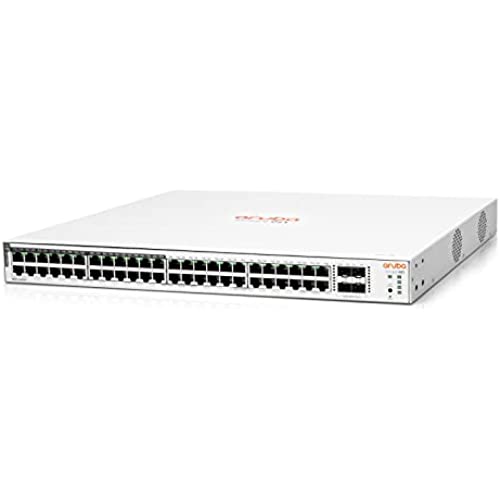
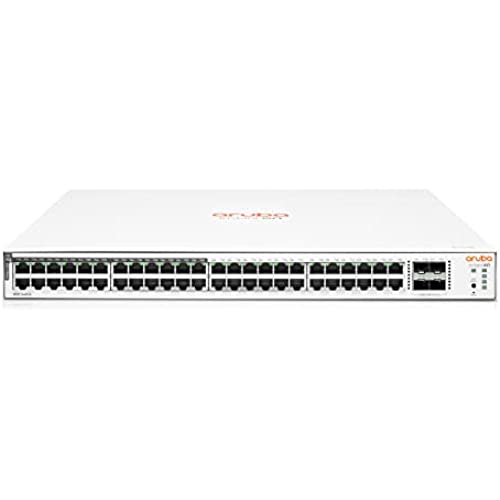
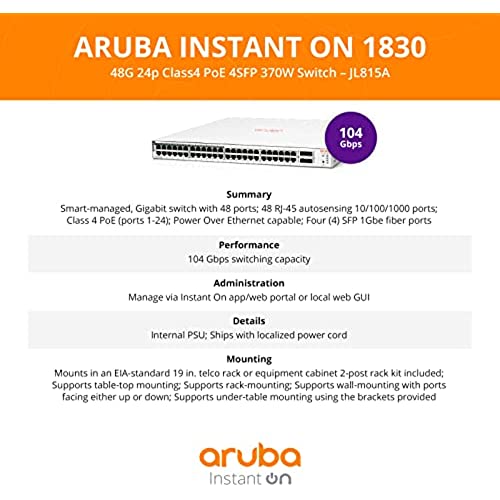
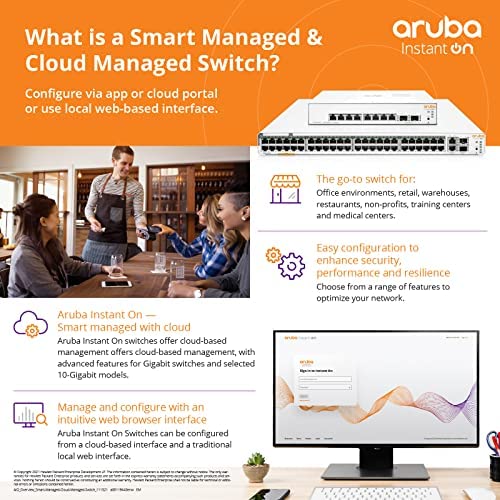

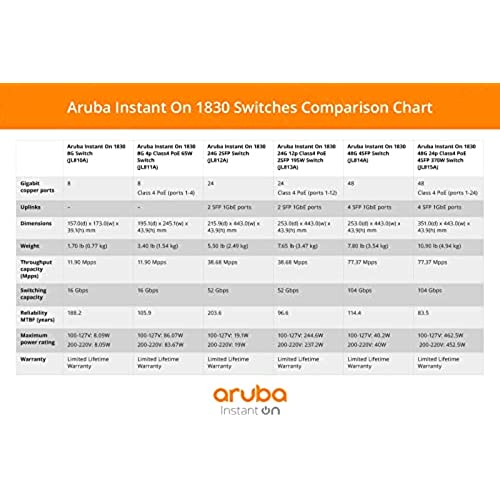








Aruba Instant On 1830 48-Port Gb | 24-Port Class 4 PoE Smart Switch (370W) - 48x 1G | 4X SFP | US Cord (JL815A#ABA)
-

R. Ferguson
> 24 hourThis review is for the JL812A, the 24 port non-POE version. It is 1U size and includes rack mount hardware or rubber feet depending on your installation. Installation is straightforward. The unit automatically calls home and downloads updates. Once youve found the address for the unit you can access it from a web browser on your network. I did not download the associated Aruba app because I have different equipment across my network and rather than jump from app to app, I just keep is simple with browser access. There is a setup wizard that takes you through naming, password, DHCP, and SNTP. This product is designed for smaller environments that do not have dedicated IT personnel or complex network requirements. That said, there is a fair amount that you can do with this box. There are two SFP ports should you have special connectivity demands. I very much like the administrative interface. It is fast and very capable. I regard this as a semi-managed switch, one that can be set up very quickly by someone with minimal knowledge but with a number of options normally available for a managed switch. I will return to this review as I explore the unit further and if any problems crop up. One last note, the unit is modestly warm but not hot.
-

Wilmer Laguna
> 24 hourExcelente. Justo lo que esperaba
-

BurazeKun
> 24 hourFirst, if you dont want to manage this via an app, you can set it up to be managed locally. Initially you have to set this up using the app though. There is no major documentation here, but install is straight forward. There is no dedicated port for using internet, though historically I would install it on port one. (In this case my short cable was too short so I installed it on port 8.) Now I got this because I needed more ports for my growing network, a network I would not call Enterprise but still required dedicated lines. This is a older style tech, where in all these options are only gigabit, which is fine as the fasted thing on my network is only 2.5gbit and there is only one of those. (Side note, I found out that my Samsung Q90T and my Sony A8H both only connect at 100mbit and I think that is a bit slow for modern TVs, though I doubt they need faster for operating streaming services.) With my note made though, there was something I thought would be a problem, I found that my TV wouldnt connect to my computer at the full 100mbit, and would start to error out at around 50-55mbit. I thought this would be a problem, but I set the stream to 40mbit and the quality of the stream was so much better than when I was able to connect at the full 100mbit through the router I was using. Moreover, latency went down so low it was almost non-existent. I was testing this using Steamlink to my Sony A8H. Outside of that, file transfers are a bit slower between devices as well, but seem to be more stable and handle smaller files better than when I used my router. I think part of this is because the router may be sending more packets at smaller sizes which helps with connectivity between devices sharing the switch. Overall, the total capacity for inter-transers is listed at 16GB, which says this should be able to do more than what I was seeing but only at 1gb per port. What I think is more impressive though is that this switch claims to have a reported life expectancy of nearly 190 years. That is a bold claim, but I look forward to passing this down in generations, though I doubt the tech here would be relevant at that time frame. But durability is really what they are claiming here. A side note, this got very warm when I first connected it, after a update it warmed up more and then leveled out at barely could tell it was warm and stayed at that lower level of heat ever since. I do have this wall mounted next to my wall mounted router/wifi. I moved every device off my router and onto my switch. I found that managing the switch was easier and much faster so that is why I did that. I have 3 ports left open for future installs, as I have my work bench running off of wifi right now and my sons setup is also wifi and could use a physical link to the network as he needs some of the game design assets I have stored locally. (We are learning to make games together.) Overall, I am impressed, albeit moderately so. I personally like the improvement in latency between devices, and I love the durability this is rated at. I do not like the small transfer speed hit I took switching to this switch, but it is small overall and handles smaller files better. This is a great device for stable connections and that is why I will recommend this as it is stable like bedrock. But if you need faster transfer speeds, I recommend getting switches that can handle that need for speed and network cards to match, I would just go all in on 10gbs network solutions in that case though but my network does not need that level of speed which is why this works for me. Price is actually very fair for, probably the last switch you will need to buy unless newer technology demands you to upgrade. This is also way better than my old Netgear switch I used to have, which I disposed for a while ago because it was not solid and caused more problems than I would like to admit. (There are Netgear switches that are good, but that one was not it and it was one of their cheapest ones so it was a, you get what you pay for, moments.) Either way, this is a good switch that I can recommend. I did think for getting the POE switch and hooking up some security cameras that wouldnt rely on a wireless network like I already have, but I thought this would be better in the end and I am not disappointed, also it would be 100 dollars more to get POE.
-

Mark
> 24 hourHave a small business and I was usually using an unmanaged switch and decided to ‘switch’ to this for a little more control. I didn’t want to pay monthly charges for a managed switch, so this really fit the bill. Now, I’ve worked with big companies, and this switch wouldn’t cut the mustard. It’s a basic managed switch. So if you are looking for enterprise level, avoid this. However, if you are a small business or home user who wants a little control and stats over your network, then this is your solution. Overall, great as a next step over unmanaged switches. I hope this review was helpful!
-

bp
> 24 hourSummary: Everything most home lab or SOHO users need in a switch at an attractive price. Details: Prior to my current career, I was studying for my Cisco networking certifications which left me somewhat dismissive of consumer-level gear. In particular, Ive always felt the need for a nice managed switch. Unfortunately it is just hard to justify buying a $1,000 infrastructure switch or even a $500 Ubiquity, and a lot of the other managed switches for home users are light on features. After all, if I am honest I just need a couple of VLANs and a few PoE ports. This piece of Aruba kit perfectly balances price and features. It provides you with 24 ports (12 Power-over-Ethernet), 2 SFP to provide interface options, and all the features most people need. Even better it has an easy to access, local web-interface that makes setting VLANs and debugging problems exceedingly easy. In particular, I really like the PoE interface which clearly explains how many watts each device is using and can even prioritize shutdowns in the case of an overly large power demand. It even has a well documented CLI interface if you prefer that. In addition to the basics it has most of the options I could see needing in a SOHO setup like spanning tree protocol and port mirroring. And all of this is clearly exposed, if not explained, in the web interface. I havent tried their remote interface and I probably will not as I prefer to run things locally, but it is a nice option to have. In addition, the hardware is solid and has a fan that changes speed depending on load. In my rack I think it is off most of the time... or at least is quieter than the other fans in the system. The only downside I see to it, ironically given its name, is that it takes a bit longer to come up after being turned on and off than I would prefer. It isnt a huge deal because this will likely be restarted once every six months or so! If you know enough about networks to need a managed switch, this will be easy to operate and setup. Plus I think it hits a real sweet spot between price and performance.
-

Phil
> 24 hourSo far, Im delighted with this switch. Installation was an absolute breeze. Plug it in, and it works. The web interface is clear and simple. Note: theres no CLI. What you see is what you get. That said, lots of configuration options are available. If you have any network experience at all, you should have everything set up and forgotten in about 15 minutes. Also, Amazon had it on my doorstep in less than a day.
-

Summit
> 24 hourThe version I got has POE available with plenty of power on tap for multiple POE access points and even a few security cameras. Its a simple layer 2 switch which is perfect for home or small office, as I dont need to manage the distribution on my home network. Aruba has been around a long time and is held in high regard in the I.T. community, and this switch certainly looks good, runs relatively quietly. Paired with a good router (Mikrotik in my case), and some good APs (Ubiquiti in my case), this is an integral part of a high-speed, reliable home or small office network. The rack mount ears install perfectly and the only real drawback was that the depth is quite a bit bigger than my other equipment and I had to adjust my wall-mount to accommodate the depth and had to purchase a right-angle power cable to reduce the amount it protrudes from the wall. Not a big deal, but the guts of these switches are surprisingly simple and a shallower depth could easily be done. This is intended for rack mounting, although it comes with some rubber feet you can install if you dont have a rack. Most racks can take the depth, but if you run an adjustable depth wall mount- keep that in mind. I think this is a great value in a high-quality piece of equipment. It always surprises me when people buy off-brand cheaper equipment when down-time can be potentially expensive and aggravating.
-

Anonymous
> 24 hourI knew it was a gamble when I purchased it, but knowing the Aruba enterprise products fairly well I felt this could be what I needed. If you need a basic, basic layer 2 switch thats not consumer grade - get this. If you want to do anything that even resembles enterprise switching, then dont. Youre better off buying an old Cisco 2960C off ebay.
-

Robert Novak
> 24 hourHPE Aruba is a known quantity, so I wasnt worried about the quality of product I would receive. This switch does take a couple minutes to boot up, which for smart/connected managed switches isnt unusual. I was able to set up my account on the mobile app while the switch powered up and got connected to Arubas cloud. Then I scanned the barcode on the back of the switch and adopted the switch. It automatically updated software, and is running happily now. The app is convenient as well, showing port status, PoE power usage, product info including serial / mac / part number and description. It also shows devices connected on each port, although right now Im just seeing a list of MAC addresses from the uplink. Will have to dig into that. It will make a slightly-overkill replacement for a Linksys switch I put in place when I replaced Meraki. So far its quiet, easy to use, and should do more than what I actually need. Nice device with no recurring costs for mobile/remote management, and the option to manage locally if I prefer.
-

Peter W
> 24 hourI was excited to get this new switch for my home network to connect my computers and wireless access points but there are some things you need to know. This switch is a very capable switch that will power up your POE cameras and access points with no problems. If you are running a flat network that just needs a switch to connect up everything is a great switch for what it is. The management is done though the cloud and it can analyze the traffic going though the switch and give you all the stats of the network down to the device that might new using a lot of data. The down side to this is it can then only be managed though the web portal and great for remote analyzing and diagnosing is a device is online or not. There is no place to set VLAN settings and while it is in cloud management mode there is no command line or able to SSH into the switch. All things must be done though the web portal and that is limited to what you can do. I would recommend this for a simple network topology as great for small localized business that need to have simple connectivity. Anything more advanced you will need to get another switch.
















